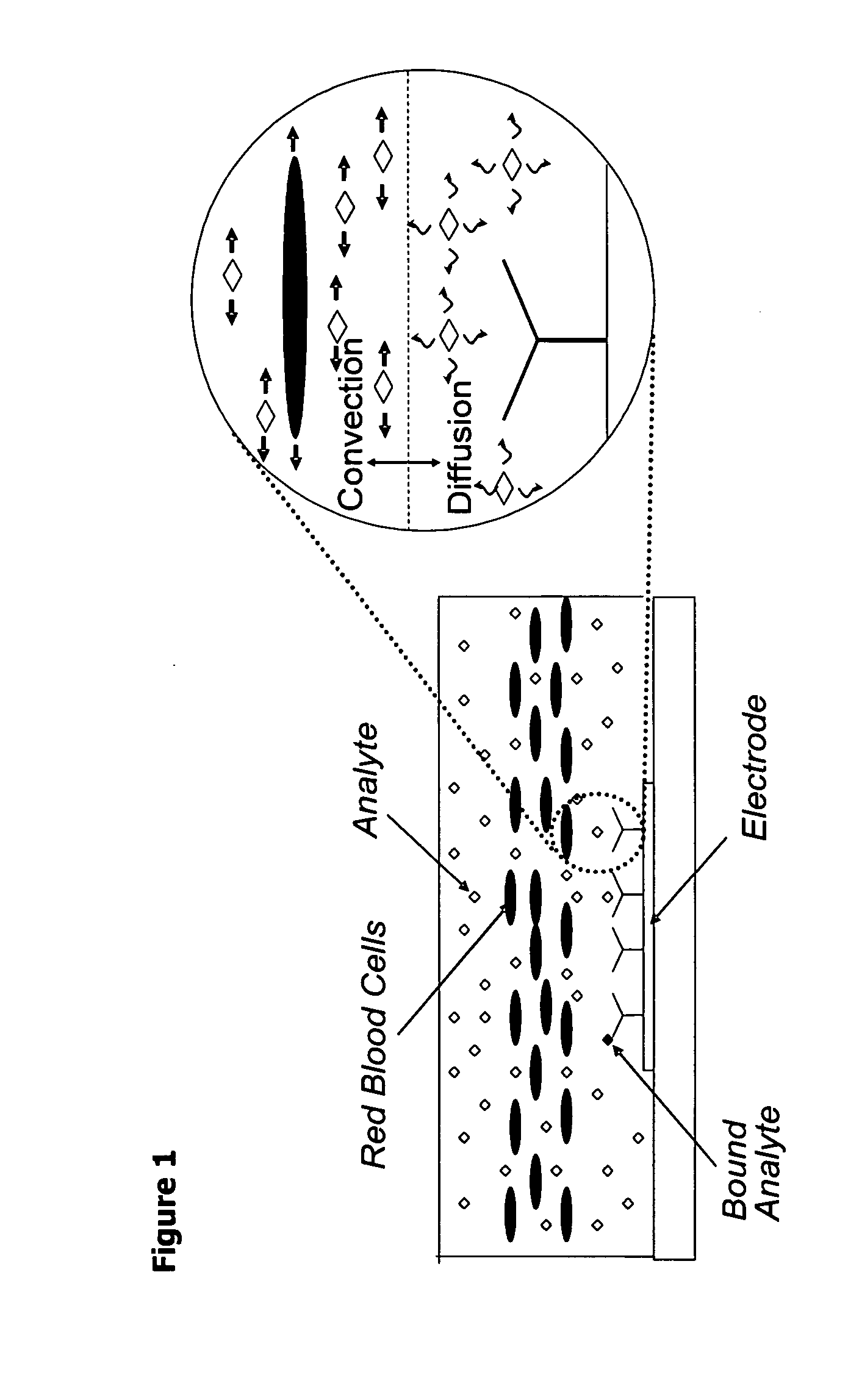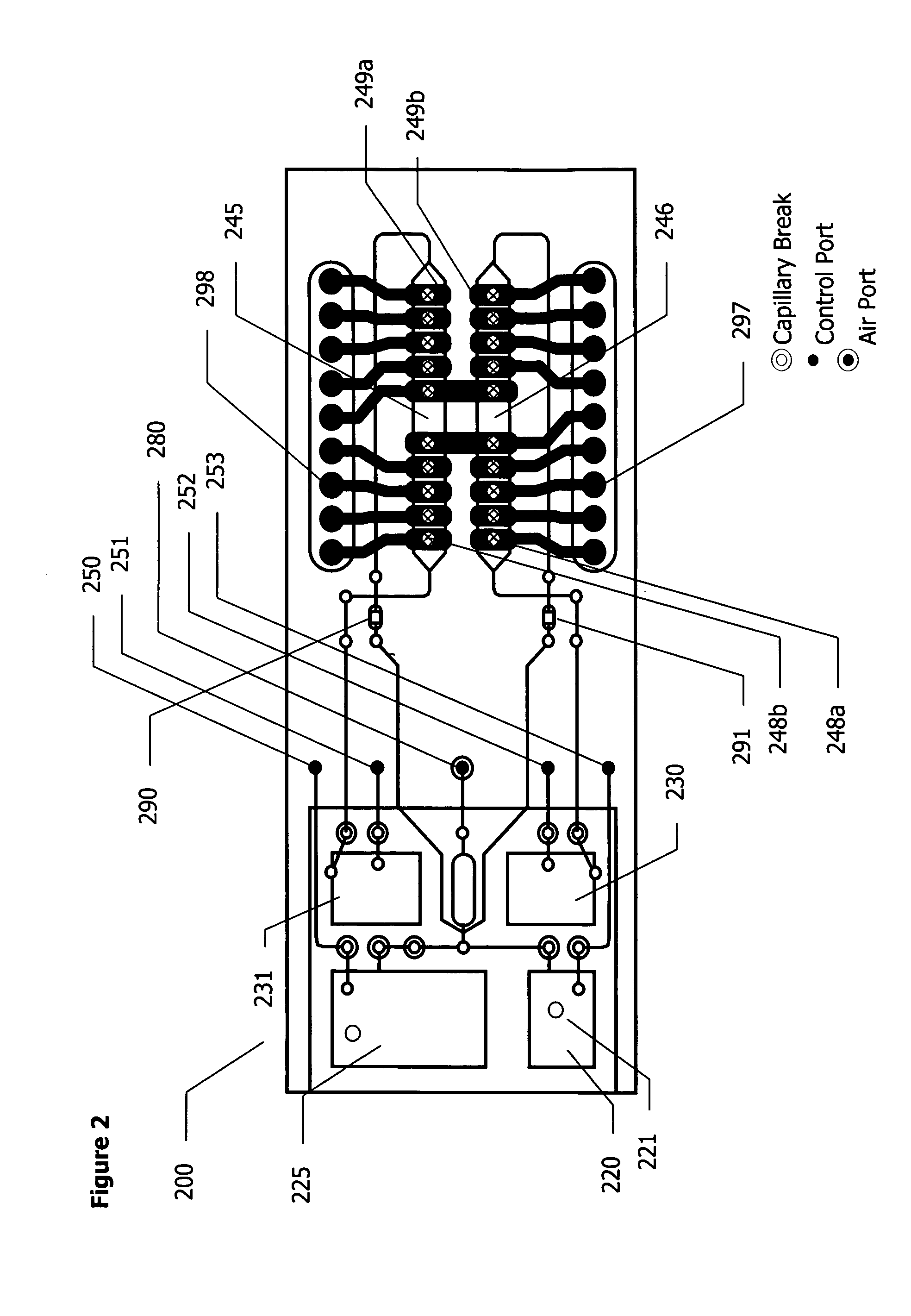Methods and apparatuses for conducting assays
a technology of assays and apparatuses, applied in the field of methods for conducting assays of samples, can solve the problems of difficult comparison of results with well established reference ranges that have been expressed, limited acceptance of assays carried out in whole blood, and difficulty in carrying out precise and accurate measurements
- Summary
- Abstract
- Description
- Claims
- Application Information
AI Technical Summary
Benefits of technology
Problems solved by technology
Method used
Image
Examples
example 1
Hematocrit-Independent One-Step Sandwich Immunoassay for Plasma Levels of Cardiac Markers in Whole Blood Samples
[0108] Six test samples having the same plasma levels of cardiac markers but different hematocrit levels were prepared as described in Materials and Methods. Table 1 provides, for each of the samples, the hematocrit, the concentration of each of the analytes in the blood sample (blood concentration) and the concentration of each of the analytes in the plasma fraction (plasma concentration).
TABLE 1HematocritBlood Concentration (ng / mL)Plasma Concentration (ng / mL)Sample(%)MyoTnICKMBTnTMyoTnICKMBTnT102002.3183.12012.3183.12191631.9152.52012.3183.13281451.7132.32012.3183.14371271.4112.22012.3183.15471071.29.51.62012.3183.1656881.07.91.42012.3183.1
[0109] A solution containing detection antibodies against myoglobin, TnI, CKMB and TnT (3.3 μl) was mixed with 160 μl of each test sample. The final antibody concentrations (in weight per total blood volume) were 2 μg / ml with the ex...
example 2
Hematocrit-Independent One-Step Sandwich Immunoassay for Plasma Levels of Cardiac Markers in Whole Blood Samples
[0111] Example 1 compared the signals obtained for whole blood samples that varied in hematocrit but contained equal levels of analyte in their plasma fractions. In this example, whole blood samples are analyzed that have equal concentrations of analyte with respect to the total volume of blood. The concentrations of analyte in the plasma should, therefore, vary as a function of the sample hematocrit.
[0112] The stock blood sample was prepared by combining 2282 μl of blood (hematocrit level of 42.5%) with 51 μl of a mixture of detection antibodies for myoglobin, cTnT, cTnI, and CKMB at concentrations 193, 97, 163, and 98 μg / ml, respectively and 33 μl of the BSA and bovine IgG blocking agent solution. Whole blood samples at four hematocrit levels were prepared from stock blood sample as described in the Materials and Methods except that the blood stock contained no added a...
example 5
Hematocrit-Independent Two-Step Sandwich Immunoassay for Plasma Levels of Cardiac Markers in Whole Blood Samples
[0118] Whole blood samples with equal plasma levels of cardiac markers but varying hematocrits were prepared as in Example 4. The detection antibody solution had 5 ug / mL of labeled anti-TnT and 3 ug / mL of anti-CKMB. The detection antibody solution also contained anti-TnI and anti-myoglobin detection antibodies; the number of labels per antibody for these two antibodies was, however, too low to get a good signal in the TnI and CKMB assays and these data are not presented.
[0119] The assays were conducted in two-step format. FIG. 8 shows the normalized signal. As observed in the analogous one step assay (Example 1), the signals were independent of hematocrit.
PUM
| Property | Measurement | Unit |
|---|---|---|
| Reynold's number | aaaaa | aaaaa |
| Reynold's numbers | aaaaa | aaaaa |
| Reynold's numbers | aaaaa | aaaaa |
Abstract
Description
Claims
Application Information
 Login to View More
Login to View More - R&D
- Intellectual Property
- Life Sciences
- Materials
- Tech Scout
- Unparalleled Data Quality
- Higher Quality Content
- 60% Fewer Hallucinations
Browse by: Latest US Patents, China's latest patents, Technical Efficacy Thesaurus, Application Domain, Technology Topic, Popular Technical Reports.
© 2025 PatSnap. All rights reserved.Legal|Privacy policy|Modern Slavery Act Transparency Statement|Sitemap|About US| Contact US: help@patsnap.com



